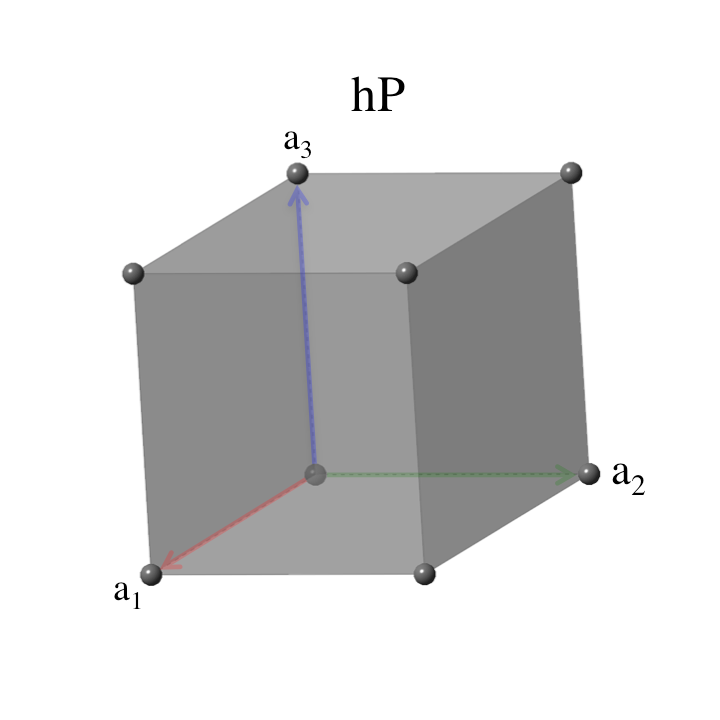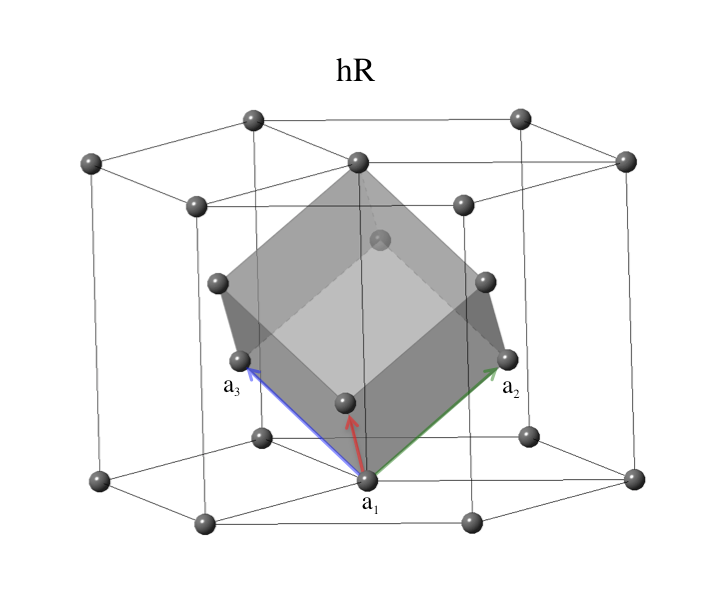The rhombohedral Bravais lattice has the periodicity of the
conventional trigonal cell, with the addition of
two translation vectors, $2/3 \mathbf{A}_1 + 1/3 \mathbf{A}_2 + 1/3
\mathbf{A}_3$ and $1/3 \mathbf{A}_1 + 2/3 \mathbf{A}_2 + 2/3 \mathbf{A}_3$.
The primitive vectors can be taken in the form:
\begin{eqnarray}
\label{equ:lat11}
\mathbf{a}_1 & = & ~ \frac{a}{2} \, \mathbf{\hat{x}} - \frac{a}{\left(2 \sqrt{3}\right)} \, \mathbf{\hat{y}} + \frac{c}{3}
\, \mathbf{\hat{z}} \nonumber \\
\mathbf{a}_2 & = & \frac{a}{\sqrt{3}} \, \mathbf{\hat{y}} + \frac{c}{3} \, \mathbf{\hat{z}} \nonumber \\
\mathbf{a}_3 & = & - \frac{a}{2} \, \mathbf{\hat{x}} - \frac{a}{\left(2 \sqrt{3}\right)} \, \mathbf{\hat{y}} + \frac{c}{3}
\, \mathbf{\hat{z}},
\end{eqnarray}
and the volume of the primitive cell is one-third that of the conventional cell,
\begin{equation}
V = \left(\frac{2}{\sqrt3}\right) \, a^2 \, c.
\label{equ:vol11}
\end{equation}
The vectors above are all of identical length,
\begin{equation}
\label{equ:rhomba}
|\mathbf{a}_1| = |\mathbf{a}_2| = |\mathbf{a}_3| = \sqrt{\frac{a^2}{3} + \frac{c^2}{9}}
\equiv a',
\end{equation}
or, equivalently, $a = b = c \equiv a'$, where we designate the
common length as $a'$ to distinguish it from the length of the first
two vectors in the conventional lattice. The vectors also make
equal angles with each other
\begin{equation}
\label{equ:rhombg}
\alpha = \beta = \gamma = \cos^{-1} \left(\frac{2 c^2 - 3 a^2}{2 \left( c^2 + 3 a^2 \right)}\right).
\end{equation}
The above equations provide another
definition of the rhombohedral lattice. We can show this by writing
the primitive vectors in a form that depends only on the common length
and separation angle.
\begin{eqnarray}
\label{equ:lat11a}
\mathbf{a}_1 & = & a' \left(
\begin{array}{c}
\sin\frac{\alpha}{2} ~ \mathbf{\hat{x}} \\
- \left(\frac{1}{\sqrt{3}}\right) \, \sin\frac{\alpha}{2} ~ \mathbf{\hat{y}} \\
+ \sqrt{\frac{1}{3}\left(4 \cos^2\frac{\alpha}{2} - 1\right)} ~ \mathbf{\hat{z}}
\end{array}
\right) \nonumber \\
\mathbf{a}_2 & = & a' \left(
\begin{array}{c}
\left(2/\sqrt{3}\right) \, \sin\frac{\alpha}{2} ~ \mathbf{\hat{y}} \\
+ \sqrt{\frac{1}{3}\left(4 \cos^2\frac{\alpha}{2} - 1\right)} ~ \mathbf{\hat{z}}
\end{array}
\right) \nonumber \\
\mathbf{a}_3 & = & a' \left(
\begin{array}{c}
- \sin\frac{\alpha}{2} ~ \mathbf{\hat{x}} \\
- \left(\frac{1}{\sqrt{3}}\right) \, \sin\frac{\alpha}{2} ~ \mathbf{\hat{y}} \\
+ \sqrt{\frac{1}{3}\left(4 \cos^2\frac{\alpha}{2} - 1\right)} ~ \mathbf{\hat{z}}
\end{array}
\right).
\end{eqnarray}
An alternative orientation is given
by
Setyawan and Curtarolo
who only give the primitive vectors in this $(a',\alpha)$ setting. The primitive
vectors used for their rhombohedral cell differ
from the equations above only by the orientation of the vectors
relative to the Cartesian axes. Their choice is simpler for
computational purposes, but does not show the relationship between
the $(a,c)$ and $(a',\alpha)$ variants.
We can define the rhombohedral lattice in two ways: as a trigonal
lattice with additional translational vectors, or as a simple
lattice with primitive vectors of equal length making equal angles with one
another. The International Tables address this ambiguity by
listing atomic positions for the rhombohedral lattice in a
hexagonal setting,
where all coordinates are referenced to the
conventional cell, and in a rhombohedral
setting,
where the coordinates are referenced to
rhombohedral lattice. To further confuse matters, the unit cell's
dimensions might be reported in terms of $(a,c)$ or in terms of $(a',\alpha)$.
An article might say that there were N atoms in the
rhombohedral cell, or 3N atoms in the conventional cell. One has to
pay attention to the context.
In the database, we will report the lattice parameters of the system
by giving $a$ and $c$, since that is the usual crystallographic
practice. However, we will record atomic positions using the
rhombohedral primitive vectors, since computer calculations
work best with the smallest number of atoms needed to describe the
system.
The space groups associated with the rhombohedral lattice
are
\begin{array}{lll}
146. ~ \mbox{R3} & 148. ~ \mbox{R$\overline{3}$} & 155. ~ \mbox{R32} \\
160. ~ \mbox{R3m} & 161. ~ \mbox{R3c} & 166. ~ \mbox{R$\overline{3}$m} \\
167. ~ \mbox{R$\overline{3}$c} & ~ & ~ \\
\end{array}


